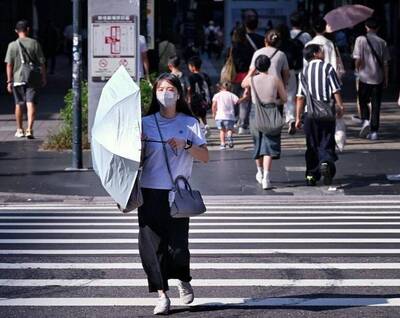Can acupuncture be used on plants?
After experimenting for 15 years, Hsiao Gui-wen (
When applied to fruit-bearing plants such as peach and apple trees, acupuncture not only advanced the harvest time by a month and a half, but also decreased damage by blight.
The technique has been patented, and many interested businesses now are in negotiation for the rights to use the technology.
Hsiao originally ran a chiropractic clinic in Yonghe. After he witnessed ginger lilies change color upon absorbing dyes, he toyed with the idea that plants may have acupuncture points like humans.
To explore the concept, Hsiao commenced worked in the early 1990s with fruit growers at Wuling Farm, Shigang (
After 8 years of research, he had built up a comprehensive map of acupuncture points on plants. He spent another 7 years after that experimenting with the effects of different needle combinations and incisions.
The peach tree that he practiced on produced a great harvest, and eventually accompanied President Chen Shui-bian (
The needles used to acupuncture plants are made of steel spokes from bicycles. The needles are about 3 to 4 times larger than those used for humans.
A fruit tree takes about 20 to 30 needles, and acupuncture can be applied to either the trunk or the branches. The exact acupuncture points are the target of the patent.
After acupuncture, Hsiao also applies his organic crop spray naturally extracted from animals or plants. Hsiao pointed out that many growers use pesticides or hormone enhancer that can damage both the environment and human health.
If his success had come 10 years earlier, Hsiao said, he could have run his own farm. However, since he is already 66 years old, he intends transferring the technique instead.
Because of his love for Taiwan, Hsiao insisted that this technique should stay in Taiwan, and not be transferred to China.
He pointed out that the earlier yields his technique produces can result in prices three to four times higher than the seasonal rate.
On the other hand, scholars from the Department of Horticulture at the National University are more conservative about the effects of acupuncture on enhancing harvest and preventing blight.
Assistant professor Yeh Te-ming (葉德銘) stated that it's common to enhance the growth of plants by changing certain environmental factors, such as the temperature, humidity or light. However, he had never heard of anyone using the acupuncture technique.
Chang Tsu-liang (張祖亮), another assistant professor said that although he had heard about research in the area of plant acupuncture at universities in Germany and in China, actual research results or scientific data are as yet unavailable.

Three Taiwanese airlines have prohibited passengers from packing Bluetooth earbuds and their charger cases in checked luggage. EVA Air and Uni Air said that Bluetooth earbuds and charger cases are categorized as portable electronic devices, which should be switched off if they are placed in checked luggage based on international aviation safety regulations. They must not be in standby or sleep mode. However, as charging would continue when earbuds are placed in the charger cases, which would contravene international aviation regulations, their cases must be carried as hand luggage, they said. Tigerair Taiwan said that earbud charger cases are equipped

Foreign travelers entering Taiwan on a short layover via Taiwan Taoyuan International Airport are receiving NT$600 gift vouchers from yesterday, the Tourism Administration said, adding that it hopes the incentive would boost tourism consumption at the airport. The program, which allows travelers holding non-Taiwan passports who enter the country during a layover of up to 24 hours to claim a voucher, aims to promote attractions at the airport, the agency said in a statement on Friday. To participate, travelers must sign up on the campaign Web site, the agency said. They can then present their passport and boarding pass for their connecting international

WEATHER Typhoon forming: CWA A tropical depression is expected to form into a typhoon as early as today, the Central Weather Administration (CWA) said yesterday, adding that the storm’s path remains uncertain. Before the weekend, it would move toward the Philippines, the agency said. Some time around Monday next week, it might reach a turning point, either veering north toward waters east of Taiwan or continuing westward across the Philippines, the CWA said. Meanwhile, the eye of Typhoon Kalmaegi was 1,310km south-southeast of Oluanpi (鵝鑾鼻), Taiwan’s southernmost point, as of 2am yesterday, it said. The storm is forecast to move through central

Taiwan sweltered through its hottest October on record, the Central Weather Administration (CWA) said yesterday, the latest in a string of global temperature records. The main island endured its highest average temperature since 1950, CWA forecaster Liu Pei-teng said. Temperatures the world over have soared in recent years as human-induced climate change contributes to ever more erratic weather patterns. Taiwan’s average temperature was 27.381°C as of Thursday, Liu said. Liu said the average could slip 0.1°C by the end of yesterday, but it would still be higher than the previous record of 27.009°C in 2016. "The temperature only started lowering around Oct. 18 or 19